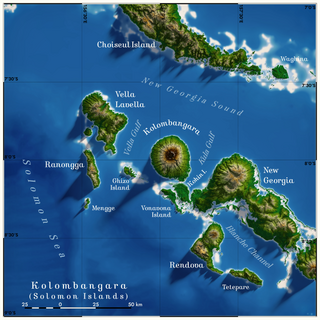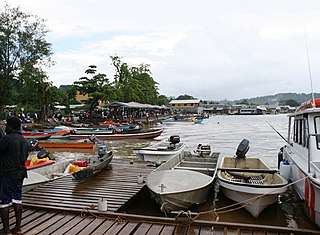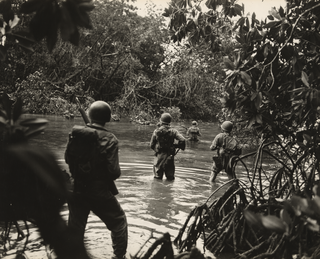
Solomon Islands is a sovereign state in the Melanesia subregion of Oceania in the western Pacific Ocean. This page is about the history of the nation state rather than the broader geographical area of the Solomon Islands archipelago, which covers both Solomon Islands and Bougainville Island, a province of Papua New Guinea. For the history of the archipelago not covered here refer to the former administration of the British Solomon Islands Protectorate, the North Solomon Islands and the History of Bougainville.

The New Georgia Islands are part of the Western Province of Solomon Islands. They are located to the northwest of Guadalcanal. The larger islands are mountainous and covered in rain forest. The main islands are New Georgia, Vella Lavella, Kolombangara, Ghizo, Vangunu, Rendova and Tetepare. They are surrounded by coral reefs and include the Marovo Lagoon.

New Georgia, with an area of 2,037 km2 (786 sq mi), is the largest of the islands in Western Province, Solomon Islands, and the 224th-largest island in the world. Since July 1978, the island has been part of the independent state of Solomon Islands.

Kolombangara is an island in the New Georgia Islands group of the nation state of Solomon Islands in the southwestern Pacific Ocean. The name is from a local language, a rough translation of its meaning is "Water Lord" with approximately 80 rivers and streams running down its flanks.

Western Province is the largest of the nine provinces of Solomon Islands. The area is renowned for its beautiful tropical islands, excellent diving and snorkelling, coral reefs and World War II wrecks, ecotourism lodges, and head-hunting shrines. The province contains many small lagoons and most of the country's tourist trade outside Honiara.
Bairoko Harbor is situated along the northwestern shore of the island of New Georgia in the Solomon Islands.

The British Solomon Islands Protectorate was first established in June 1893, when Captain Herbert Gibson of HMS Curacoa declared the southern Solomon Islands a British protectorate.

Gizo is the capital of the Western Province in Solomon Islands. With a population of 7,177, it is the third largest town in the country. It is situated on Ghizo Island approximately 380 kilometres west-northwest of the capital, Honiara, and is just southwest of the larger island of Kolombangara.

Rendova is an island in Western Province, in the independent nation of Solomon Islands, in the South Pacific, east of Papua New Guinea.

Arundel Island is an island of the New Georgia Islands archipelago in the Western Province of Solomon Islands. Its indigenous names are Kohinggo and Ndokulu.
Munda International Airport is an international airport adjacent to the town of Munda, Western Province in Solomon Islands.
Charles Morris Woodford was a British naturalist and government minister active in the Solomon Islands. He became the first Resident Commissioner of the Solomon Islands Protectorate, serving from 1896 until 1915.

The Drive on Munda Point was an offensive by mainly United States Army forces against Imperial Japanese forces on New Georgia in the Solomon Islands from 2–17 July 1943. The Japanese forces, mainly from the Imperial Japanese Army, were guarding an airfield at Munda Point on the western coast of the island that the U.S. wished to capture as one of the key objectives of the New Georgia campaign. After landing around Zanana on 2 July from Rendova, U.S. troops began a westward advance towards the airfield at Munda. Held up by difficult terrain and stubborn Japanese defense, elements of three U.S. regiments advanced slowly along the Munda trail over the course of two weeks. The slow progress resulted in a reorganization of the U.S. forces assigned to the drive, and preparations were made for a corps-level offensive, but before this could be launched, the Japanese launched a counterattack on 17 July.
Kiambe is a small island in Western Province, in the independent nation of Solomon Islands.

Sir Edward George Sayers was a New Zealand medical doctor, parasitologist, Methodist missionary, military medical administrator, consultant physician and, from 1958 to 1968, Dean of the University of Otago, School of Medicine. Having trained as a doctor, from 1927 to 1934 he worked at the Methodist mission in the Solomon Islands where he carried out fieldwork in the treatment of malaria. The significance of this work became apparent when Sayers used his knowledge to reduce deaths of American, Australia and New Zealand military forces during the invasion of Pacific Islands during World War II. He served as a doctor with the 2nd Division 2 NZEF during 1941–42 in Greece and North Africa. In 1942 he was transferred to the Pacific to serve with the 3rd Division, 2 NZEF IP.
The Kalikoqu are an ethnic Melanesian tribe who are concentrated in the New Georgia island of the Solomon Islands. Prior to European colonization, they resided in the eastern side of the western Roviana lagoon and established the concept of the right to property by interlinking it with marriage. Before, during and after the British Empire's establishment of the Solomon Islands Protectorate in the late Victorian era, the Kalikoqu were greatly expanded by neighboring Melanesian tribes immigrating to the Solomon Islands interior.

Tomako or tomoko is a large war canoe from the Solomon Islands. The name "tomako" is used in New Georgia in the Roviana language. It is also known as magoru in Marovo, niabara in Vella Lavella, mon in Bougainville, ora in Makira, and iola or ola in Malaita and Ulawa. Tomako were narrow and usually between 12 and 18 m in length. They did not possess outriggers or sails and were propelled solely by paddling. They were built by fitting planks edge-to-edge which are then "sewn" together and caulked with a paste made from the nut of the tree Parinarium laurinum. They could carry 30 to 50 warriors, and were used in raiding expeditions for slaves or for headhunting. They were characteristically crescent-shaped, with sharply upturned prows and sterns that were decorated with fringes of cowrie shells, nautilus shells, and mother-of-pearl, as well as intricate carvings. These carvings are usually of spirit animals or warriors like the kesoko and Tiolo. The body is commonly blackened to contrast with the decorations.

The Battle of Arundel Island was fought from 27 August – 21 September 1943, primarily between United States Army and Imperial Japanese Army forces on Arundel Island during the New Georgia campaign in the Pacific War. The battle took place towards the end of the campaign after the capture of Munda airfield and mopping up operations in western New Georgia had resulted in the Japanese evacuation of mainland New Georgia. The US high command decided to occupy the island so that it could be used as a base for artillery to fire on the main Japanese troop concentration on Kolombangara.
John Francis Goldie founded the Methodist Mission in New Georgia Islands, which are part of the Solomon Islands. He was chairman of the Solomon Island District of the Methodist Mission from 1902 until his retirement in 1951.
Arthur William Mahaffy O.B.E. was a colonial administrator who served in the Gilbert and Ellice Islands Protectorate, the British Solomon Islands Protectorate, the Colony of Fiji, the Anglo-French Condominium of the New Hebrides, with his final post being the Administrator of Dominica.














